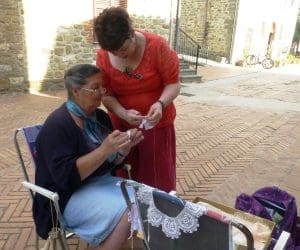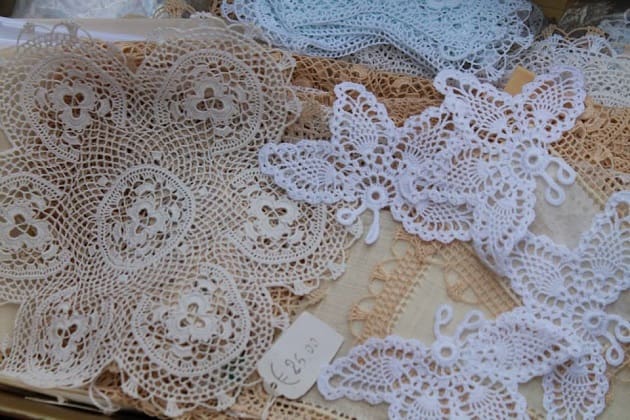 In the early 20th century, Marchesa Elena Guglielmi introduced the technique of Irish lace-making to Isola Maggiore in Lake Trasimeno. Inspired by traditions originating in Irish monasteries in the late 19th century and following the ancient art of Venetian lace, the Marchesa’s vision was to bring this artistry to the island.
In the early 20th century, Marchesa Elena Guglielmi introduced the technique of Irish lace-making to Isola Maggiore in Lake Trasimeno. Inspired by traditions originating in Irish monasteries in the late 19th century and following the ancient art of Venetian lace, the Marchesa’s vision was to bring this artistry to the island.
Unlike traditional lace made with needles and bobbins, this lace is crafted with a crochet hook using an extremely fine thread. The foresight of the Marchesa also led her to bring a teacher from Turin who could pass on the art of lace-making to the first island teacher, Elvira Tosetti. Elvira was entrusted with the foundation and direction of the lace school on the island for young women, daughters of fishermen, who, until then, engaged in various activities during the day without receiving any payment. The school provided them with the opportunity to receive professional training, learning various techniques for creating tablecloths, sheets, clothes, handkerchiefs, gloves, etc. This offered them a certain economic independence (earning about 390 lire in the first year and around 2300 lire in the second year) and the ability to contribute to family expenses.
They could be seen sitting at the doorstep of their homes, engrossed in crocheting and lacework. These young women and their creations soon gained esteem from noblewomen, regular customers of the school. The crafted items were soon exhibited at the permanent market show of Italian Decorative Arts in Perugia, and sample books were sent to Industrie Femminili Italiane in Rome, ultimately being sold throughout Italy and abroad. The Irish lace from Isola Maggiore became famous and highly appreciated, positively contributing to the island’s economy, especially during fishing crises.
Later, in the 1930s, with changes in fashion and influences coming from America, Irish lace fell out of style, leading to the closure of the school. However, the island women continued to work on lace for their personal trousseaus and as an inheritance.
In 1963, Isolana Maria Vittoria Semolesti revived the activity by founding a cooperative of lace makers for the sale of Irish lace. Although the cooperative closed in 1975, the lace makers continued to work individually. Via Guglielmi, with its lace makers, became one of the attractions on the island, drawing tourists who admired the lace-making process. Even today, you can find a few lace makers working at their doorsteps.
The last lace makers of Isola Maggiore, all descendants of Maria Vittoria Semolesti’s school, still operate today. In the center of the island, in the palace that once housed the Brotherhood of Santa Maria dei Disciplinati, the Lace Museum was established, showcasing the works created by the women of Isola Maggiore from 1904 to the end of the 20th century.




